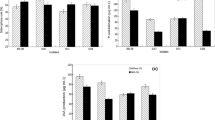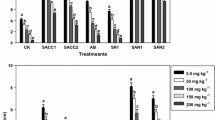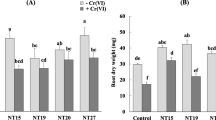Abstract
Cadmium (Cd) is one of the most toxic contaminants in the environment. The contamination of crop fields with metals like Cd may lead to a significant decrease in productivity due to related toxicity. The present study was conducted with aim to enhance the growth of rice (Oryza sativa), in Cd contaminated soil, by the application of heavy metal resistant—plant growth promoting rhizobacteria, Serratia marcescens S2I7. S2I7 was found to be highly resistant to Cd and positive for phosphate solubilization, production of siderophore, indole acetic acid (IAA), and hydrogen cyanide (HCN). The organism was found to have Glutathione S-transferase (GST) mechanism for detoxification of Cd. GST was induced and its activity was increased significantly in the presence of Cd. When the bacterial strain was applied to rice seedlings, the germination index and growth of seedling were improved in spite of Cd contamination in soil. Pot trial experiments in laboratory conditions showed that the growth of the plants was not affected up to the moderate concentration of Cd (0.75 M), and removal of Cd from the soil was also high (66 mg/kg after 20 days). Interestingly, at low concentration of Cd (0.25 M), there was no significant removal of residual Cd from the soil. However, under the high concentration, rate of removal of Cd was very less after 20 days which may be due to toxic effects (of higher concentration). Here the plant–microbe association may need more time to overcome the effects of Cd and to lead to removal of the metal. Moreover, with the application of isolate S2I7, the growth of the rice plant was comparatively better, as the mean shoot length was increased by 7.9%, and mean root length was increased by 53.7%. Therefore, the application of multifunctional plant-growth promoting bacteria exhibiting resistance for Cd may result in better growth of rice under the stress of the heavy metal. This may also improve the remediation of contaminated sites by alleviating Cd-induced phytotoxicity and promoting the growth of plants.





Similar content being viewed by others
References
Ahmad MS, Ashraf M (2011) Essential roles and hazardous effects of nickel in plants. Rev Environ Contam Toxicol 214:125–67. https://doi.org/10.1007/978-1-4614-0668-6_6:
Ahsan N, Lee SH, Lee DG, Lee H, Lee SW, Bahk JD et al (2007) Physiological and protein profiles alternation of germinating rice seedlings exposed to acute cadmium toxicity. C R Biol 330:735–746
Biswas JK, Mondal M, Rinklebe J, et al (2017) Multi-metal resistance and plant growth promotion potential of a wastewater bacterium Pseudomonas aeruginosa and its synergistic benefits. Environ Geochem Health 39(6):583–1593. https://doi.org/10.1007/s10653-017-9950-5
Chen RS, Chen WY, Tsay JG (2018) Molecular characterization of cadmium-resistant Cupriavidus spp. and Ralstonia solanacearum isolated from soil and plants in Taiwan. Int J Environ Agriculture Res. 4(1):43–55.
Chien C, Lin B, Wu C (2013) Biofilm formation and heavy metal resistance by an environmental Pseudomonas sp. Biochem Eng J 78:132–137
Christensen GD, Bisno AL, Simpsom WA, Beachey EH (1982) Adherence of slime producing strains of staphylococcus epidermidis to smooth surfaces. Infect Immun. 37:318–326
Fan M, Liu Z, Nan L, Wang E, Chen W, Lin Y, Wei G (2018) Isolation, characterization, and selection of heavy metal-resistant and plant growth-promoting endophytic bacteria from root nodules of Robinia pseudoacacia in a Pb/Zn mining area. Microbiol Res 217:51–59
Fergusson JE (1990) The heavy elements: chemistry environmental impact and health effects. Pergamon Press, Oxford
Freeman DJ, Falkiner FR, Keane CT (1989) A new method for detecting slime production by coagulase-negative staphylococci. J Clin Pathol 42:872–874
Habig WH, Pabst MJ, Jacoby WB (1974) Glutathione S-transferases: the first enzymatic step in mercapturic acid formation. J Biol Chem 249:7130–7139
Harrison JJ, Ceri H, Turner RJ (2007) Multimetal resistance and tolerance in microbial biofilms. Nat Rev Microbiol 5:928–938
Heinemann B, Howard AJ, Palocz HJ (1970) Influence of dissolved oxygen levels on production of L-asparaginase and prodigiosin by Serratia marcescens. Appl Microbiol. 19(5):800–804
Hookom M, Puchooa D (2013) Isolation and identification of heavy metals tolerant bacteria from industrial and agricultural areas in mauritius. CRMB 1(3):119–123
Khamna S, Yokota A, Lumyong S (2009) Actinomycetes isolated from medicinal plant rhizosphere soil: diversity and screening of antifungal compound indole-3-acetic acid and siderophore production. World J Microbiol Biotechnol 25:649–655
Kilic NK, Donmez G (2008) Environmental conditions affecting exopolysaccharide production by Pseudomonas aeruginosa, Micrococcus sp., and Ochrobactrum sp. J Hazard Mater 154:1019–1024
Kim M, Ahn IY, Cheon J, Park H (2009) Molecular cloning and thermal stress-induced expression of a pi-class glutathione S-transferase (GST) in the Antarctic bivalve Laternula elliptica Comp Biochem Physiol A, 152:207–213.
Kotoky R, Pandey P (2018) Plant-microbe symbiosis as an instrument for the mobilization and removal of heavy metals from contaminated soils-a realistic approach. Curr Biotechnol 7(2):71–79
Kotoky R, Das S, Singha LP, Pandey P, Singha KM (2017) Biodegradation of Benzo(a)pyrene by biofilm-forming and plant growth promoting Acinetobacter sp, strain PDB4. Environ Technol Innovation 8:256–268
Kotoky R, Singha LP, Pandey P (2017) Draft genome sequence of Heavy Metal resistant soil bacterium, Serratia marcescens S2I7, with ability to degrade polyaromatic hydrocarbons. Genome Announcements. 5(48):e01338–e1417
Kuffner M, De Maria S, Puschenreiter M, Fallmann K, Wieshammer G et al (2010) Culturable bacteria from Zn-and Cd-accumulating Salix caprea with differential effects on plant growth and heavy metal availability. J App Microbiol 108:1471–1484
Kumar S, Asif MH, Chakrabarty D, Tripathi RD, Dubey RS, Trivedi PK (2013) Expression of a rice Lambda-class of glutathione S-transferase OsGSTL2 in Arabidopsis provides tolerance to heavy metal and other abiotic stresses. J Hazard Mat 248:228–237
Kumar S, Stecher G, Tamura K (2016) MEGA7: molecular evolutionary genetics analysis version 7.0 for bigger datasets. Mol Biol Evol 33(7):1870–1874. https://doi.org/10.1093/molbev/msw054
Lin X, Mou R, Cao Z, Xu P, Wu X, Zhu Z, Chen M (2016) Characterization of cadmium-resistant bacteria and their potential for reducing accumulation of cadmium in rice grains. Sci Total Environ. 569–570:97–104. https://doi.org/10.1016/j.scitotenv.2016.06.121 (Epub 2016 Jun 21)
Liu D, Liu Y, Rao J, Wang G, Li H, Ge F et al (2013) Overexpression of the glutathione S-transferase gene from Pyrus pyrifolia fruit improves tolerance to abiotic stress in transgenic tobacco plants. Mol Biol 47:591–601
Morel M, Ngadin AA, Droux M, Jacquot JP, Gelhaye E (2009) The fungal glutathione S-transferase system, evidence of new classes in the wood-degrading basidiomycete Phanerochaete chrysosporium. Cell Mol Life Sci 66:3711–3725
Mulik A, Kumbhar P, Bhadekar R (2017) Production and partial characterization of pigments produced by Kocuria sp BRI 36: influence of heavy metals. Int J Pharm Pharm Sci. 9(10):137–145
Naz N, Young HK, Ahmed N, Gadd GM (2005) Cadmium accumulation and dna homology with metal resistance genes in sulfate-reducing bacteria. Appl Environ Microbiol. 71(8):4610–4618. https://doi.org/10.1128/AEM.71.8.4610-4618.2005
Oger C, Berthe T, Quillet L, Barray S, Chiffoleau JF, Petit F (2001) Estimation of the abundance of the cadmium resistance gene cadA in microbial communities in polluted estuary water. Res Microbiol 152(7):671–678
Oliveros JC (2015) Venny, an interactive tool for comparing lists with Venn's diagrams. https://bioinfogp.cnb.csic.es/tools/venny/index.html. Accessed June 2018
Ovecka M, Takac T (2014) Managing heavy metal toxicity stress in plants: biological and biotechnological tools. Biotechnol. Adv 32:73–86
Pal A, Paul AK (2008) Microbial extracellular polymeric substances: central elements in heavy metal bioremediation. Indian J Microbiol 48:49–64
Pant R, Pandey P, Kotoky R (2016) Rhizosphere mediated biodegradation of 14-dichlorobenzene by plant growth promoting rhizobacteria of Jatropha curcas. Ecol Eng 94:50–56
Pourrut B, Shahid M, Dumat C, Winterton P, Pinelli E (2011) Lead uptake toxicity and detoxification in plants. Rev Environ Contam Toxicol 213:113–136
Rahoui S, Chaoui A, El-Ferjani EJ (2010) Membrane damage and solute leakage from germinating pea seed under cadmium stress. Hazard Mater 178:1128–1131
Raja P, Veerasingam S, Suresh G, Marichamy G, Venkatachalapathy R (2009) Heavy metal concentration in four commercially valuable marine edible fish species from Parangipettai coast, south east coast of India. J Animal Veterinary Adv 1(1):10–14
Raskin I, and Ensley, D (2000) Phytoremediation of toxic metals: using plants to clean up the environment. Wiley, New York, 2000.
Reysenbach AL, Giver LJ, Wickham GS, Pace NR (1992) Differential amplification of rRNA genes by polymerase chain reaction. Appl Environ Microbiol 58:3417–3418
Sarwar M, Kremer RJ (1995) Enhanced suppression of plant growth through production of L-tryptophan-derived compounds by deleterious rhizobacteria. Plant Soil 172:261–269
Sayyed R, Chincholkar S (2010) Growth and siderophores production in Alcaligenes faecalis is regulated by metal ions. Indian H Microbiol 50:179–182
Shen M, Zhao DK, Qiao Q, Liu L, Wang JL, Cao GH et al (2015) Identification of glutathione S-transferase (GST) genes from a dark septate endophytic fungus (Exophiala pisciphila) and their expression patterns under varied metals stress. PLoS ONE 10(4):e0123418. https://doi.org/10.1371/journal.pone0123418
Smiri M, Chaoui A, Rouhier N, Gelhaye E, Jacquot JP, El-Ferjani E (2011) Cadmium affects the glutathione/glutaredoxin system in germinating pea seeds. Biol Trace Elem Res 142:93–105
Stohs SJ, Bagchi D (1995) Oxidative mechanisms in the toxicity of metal-ions. Free Radic Biol Med 18:321–336
Tamura K, Nei M (1993) Estimation of the number of nucleotide substitutions in the control region of mitochondrial DNA in humans and chimpanzees. Mol Biol Evol 10:512–526
Tamura K, Stecher G, Peterson D, Filipski A, Kumar S (2013) MEGA6: molecular evolutionary genetics analysis version 6,0. Mol Biol Evol 30:2725–2729
Tirry N, Tahri Joutey N, Sayel H, Kouchou A, Bahafid W, Asri M, El Ghachtouli N (2018) Screening of plant growth promoting traits in heavy metals resistant bacteria: prospects in phytoremediation. J Genetic Eng Biotechnol 16:613–619
Trajanovska S, Britz ML, Bhave M (1997) Detection of heavy metal ion resistance genes in gram-positive and gram-negative bacteria isolated from a lead-contaminated site. Biodegradation 8:113–124
Trummler K, Effenberger F, Syldatk C (2003) An integrated microbial/enzymatic process for the production of rhamnolipids and L-rhamnose from rapeseed oil with Pseudomonas sp DSM 2874. Eur J Lipid Sci Technol 105:563571
Vallee BL, Ulmer DD (1972) Biochemical effects of mercury cadmium and lead. Annu Rev Biochem 41:91–128
Verma T, Srinath T, Gadpayle RU, Ramteke PW, Hans RK, Garg SK (2001) Chromate tolerant bacteria isolated from tannery effluent. Biores Technol 78:31–35
Victoria AJ, Cao E, Salmaso N, Segata N, Donati C (2018) Draft genome sequence of the cadmium-resistant strain JJU2, belonging to the family Hapalosiphonaceae of the cyanobacteria. Microbiol Resour Announc 7:e00876–e918. https://doi.org/10.1128/MRA.00876-18
Vos P, Garrity G, Jones D, Krieg NR, Ludwig W, Rainey FA, Schleifer KH, Whitman WB (eds) (2009) Bergey’s manual of systematic bacteriology. Springer-Verlag, New York
Vullo DL, Ceretti HM, Daniel MA, Ramirez SAM, Zalts A (2008) Cadmium zinc and copper biosorption mediated by Pseudomonas veronii 2E. Bioresour Technol 99:5574–5581
Wang QR, Cui YS, Liu XM, Dong YT, Christie P (2003) Soil contamination and plant uptake of heavy metals at polluted sites in China, J Environ Sci Health Part A Toxic/Hazardous Substances Environ Engi, 38(5):823–838. https://doi.org/10.1081/ESE-120018594
Williams RP, Gott CL, Qadri SM (1971) Induction of pigmentation in nonproliferating cells of Serratia marcescens by addition of single amino acids. J Bacteriol. 106(2):444–448
Winshell EB, Neu HC (1974) Relation of cell wall lipid content of Serratia marcescens to resistance to antimicrobial agents. Antimicrobial Agents and Chemotherapy 6(1):73–75. https://doi.org/10.1128/AAC.6.1.73
Wood JM (1974) Biological cycles for toxic elements in the environment. Sci 4129:1049–1105
Yu XL, Sun RJ, Yan HR, Guo XQ, Xu BH (2012) Characterization of a sigma class glutathione S-transferase gene in the larvae of the honeybee (Apis cerana cerana) on exposure to mercury. Comp Biochem Phys 161:356–364. https://doi.org/10.1016/j.cbpb.2011.12.009
Yu X, Li Y, Zhang C, Liu H, Liu J, Zheng W et al (2014) Culturable heavy metal-resistant and plant growth promoting bacteria in v-ti magnetite mine tailing soil from panzhihua China. PLoS One 9(9):e106618
Zhai Q, Xiao Y, Zhao J, Tian F, Zhang H, Narbad A, Chen W (2017) Identification of key proteins and pathways in cadmium tolerance of Lactobacillus plantarum strains by proteomic analysis. Sci Rep. 7:1182. https://doi.org/10.1038/s41598-017-01180-x
Zhang LB, Qiu LH, Wu HF, Liu XL, You LP, Pei D et al (2012) Expression profiles of seven glutathione S-transferase (GST) genes from Venerupis philippinarum exposed to heavy metals and benzo[a]pyrene. Comp Biochem Phys 155:517–527. 10,1016/j,cbpc,2012,01,002
Zhang h, Cui B, Xiao R, Zhao H, (2010) Heavy metals in water soil and plants in rivarian wetlands in the pearl river estuary South China. Procedia Environ Sci 2:1344–1354
Acknowledgements
PP acknowledges the Department of Biotechnology (DBT), Government of India for financial support. RK acknowledge Department of Science and Technology (DST), Government of India, for INSPIRE fellowship.
Author information
Authors and Affiliations
Corresponding author
Ethics declarations
Conflict of interest
The authors declare no conflict of interest.
Additional information
Publisher's Note
Springer Nature remains neutral with regard to jurisdictional claims in published maps and institutional affiliations.
Rights and permissions
About this article
Cite this article
Kotoky, R., Nath, S., Kumar Maheshwari, D. et al. Cadmium resistant plant growth promoting rhizobacteria Serratia marcescens S2I7 associated with the growth promotion of rice plant. Environmental Sustainability 2, 135–144 (2019). https://doi.org/10.1007/s42398-019-00055-3
Received:
Revised:
Accepted:
Published:
Issue Date:
DOI: https://doi.org/10.1007/s42398-019-00055-3




